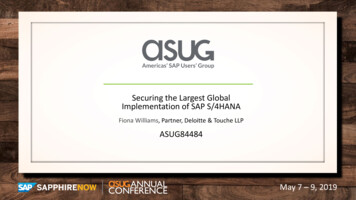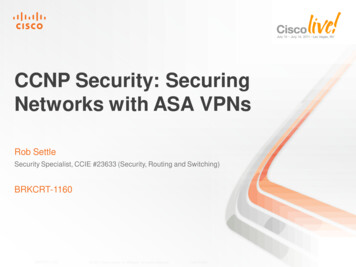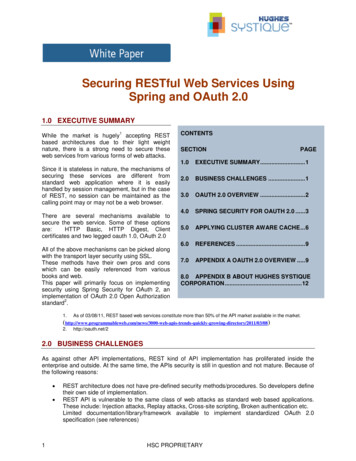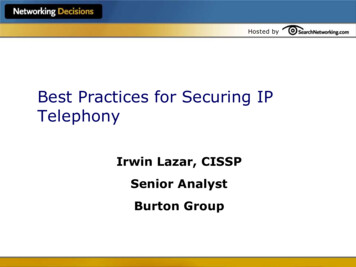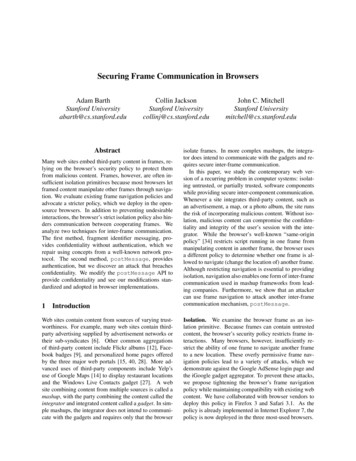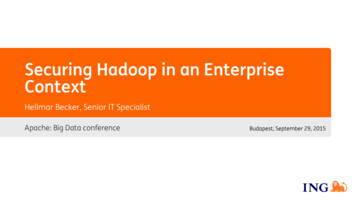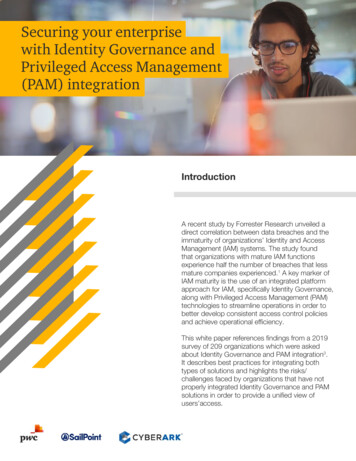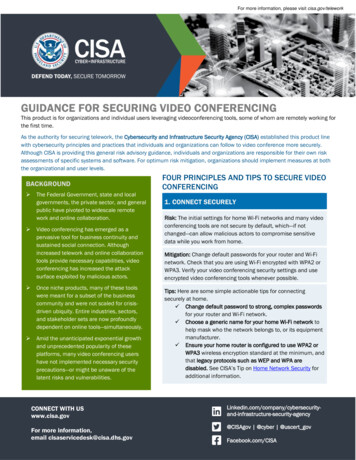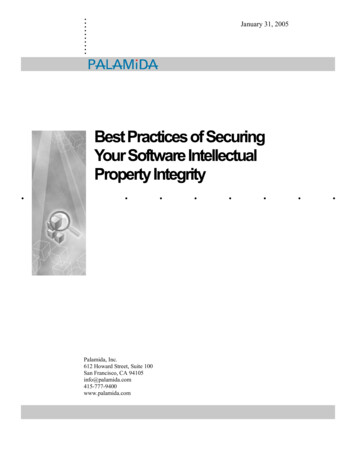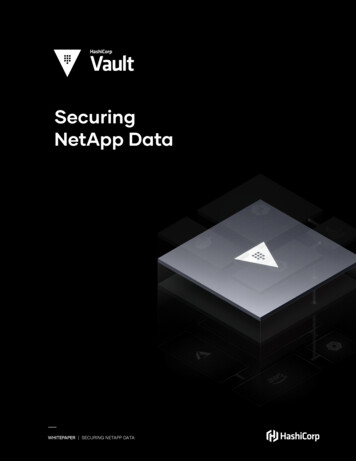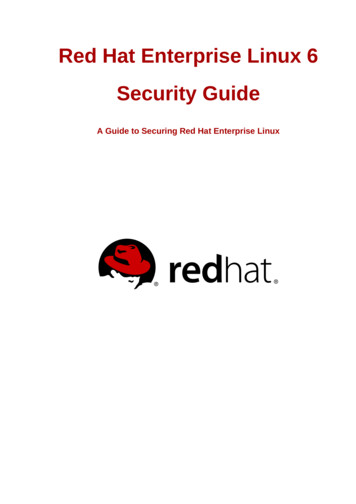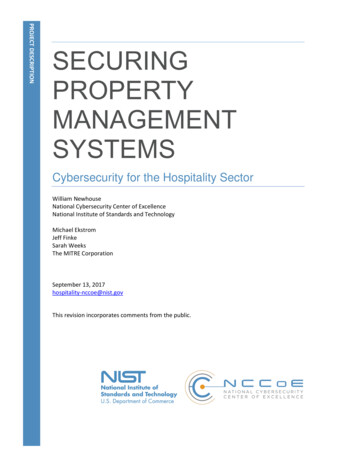
Transcription
PROJECT ecurity for the Hospitality SectorWilliam NewhouseNational Cybersecurity Center of ExcellenceNational Institute of Standards and TechnologyMichael EkstromJeff FinkeSarah WeeksThe MITRE CorporationSeptember 13, 2017hospitality-nccoe@nist.govThis revision incorporates comments from the public.
The National Cybersecurity Center of Excellence (NCCoE), a part of the National Institute of Standardsand Technology (NIST), is a collaborative hub where industry organizations, government agencies, andacademic institutions work together to address businesses’ most pressing cybersecurity challenges.Through this collaboration, the NCCoE develops modular, easily adaptable example cybersecuritysolutions demonstrating how to apply standards and best practices using commercially availabletechnology. To learn more about the NCCoE, visit https://nccoe.nist.gov. To learn more about NIST, visithttps://www.nist.gov.This document describes a particular problem that is relevant across the hospitality sector. NCCoEcybersecurity experts will address this challenge through collaboration with members of the hospitalitysector and vendors of cybersecurity solutions. The resulting reference design will detail an approachthat can be used by hotels and other hospitality organizations.ABSTRACTHospitality organizations rely on Property Management Systems (PMS) for daily tasks, planning, andrecord keeping. As the operations hub, the PMS interfaces with several services and components withina hotel’s IT system, such as Point-of-Sale (POS) systems, door locks, Wi-Fi networks, and other guestservice applications. Adding to the complexity of connections, external business partners’ componentsand services are also typically connected to the PMS, such as on-premise spas or restaurants, onlinetravel agents, and customer relationship management partners or applications (on-premise or cloudbased). [1] The numerous connections to and users of the PMS could provide a broader surface forattack by malicious actors. [2] Demonstrating methods to improve the security of the PMS can helpprotect the business from network intrusions that might lead to data breaches and fraud. [3]Based on industry research and in collaboration with hospitality industry stakeholders, the NCCoE isstarting a project that aims to help hospitality organizations implement stronger security measureswithin and around the PMS, with a focus on the POS system through network segmentation, point-topoint encryption, data tokenization, Multifactor Authentication (MFA) for remote and partner access,network and user behavior analytics, and business-only usage restrictions.In collaboration with the hospitality business community and technology vendors who implementstandards that improve cybersecurity, the NCCoE will explore methods to strengthen the security of thePMS and its connections and will develop an example implementation composed of open-source andcommercially available components. This project will produce a NIST Cybersecurity Practice Guide—afreely available description of the solution and practical steps needed to effectively secure the PMS andits many connections within the hotel IT system.KEYWORDSBehavior analytics; hospitality cybersecurity; MFA; network analytics; network segmentation; point ofsale; point-to-point encryption; property management system; tokenizationDISCLAIMERCertain commercial entities, equipment, products, or materials may be identified in this document inorder to describe an experimental procedure or concept adequately. Such identification is not intendedto imply recommendation or endorsement by NIST or NCCoE, nor is it intended to imply that theentities, equipment, products, or materials are necessarily the best available for the purpose.Project Description: Securing Property Management Systems1
CONTENTS1Executive Summary . 3Purpose. 3Scope . 3Assumptions . 3Background . 32Scenarios . 4Scenario 1: Guest checks in, accrues incidentals – Tokenization, P2PE, Network and User Analytics. 4Scenario 2: Third-party service provider remotely accesses hotel system – MultifactorAuthentication, Access Control, Network and User Analytics . 43High-Level Architecture . 5Component List . 5Desired Characteristics . 6Auditing and Analytics capabilities such as: . 64Relevant Standards. 75Security Control Map. 7Appendix A References . 9Project Description: Securing Property Management Systems2
1 EXECUTIVE SUMMARYPurposeThe purpose of this project is to help hoteliers implement stronger security measures and reducevulnerabilities within and around their Property Management Systems (PMS), with a focus on theconnection to a point-of-sale (POS) system. The project will identify typical hotel IT infrastructures andPMS-POS configurations, systems, and components that integrate or interface with both applications.The project will also identify interactions between hoteliers and authorized third-party service provider(SP) systems (e.g., online booking or customer relationship marketing partners).The publication of this Project Description is the beginning of a process that will identify projectparticipants, as well as standards-based, commercially available, and/or open- source hardware andsoftware components. These products will be integrated and implemented in a laboratory environmentto build open, standards-based, modular, end-to-end reference designs that will address the securitychallenges introduced by networking the PMS and POS. The approach may include architecturaldefinition, logical design, build development, security character analysis, security control mapping, andfuture build considerations. The output of the process will be the publication of a multi-volume NISTCybersecurity Practice Guide that will help hoteliers implement stronger PMS-POS security.ScopeThe scope of this example solution includes the implementation of point-to-point encryption (P2PE),data tokenization, MFA for remote and partner access, risk calculation, access control (it is assumedthat, at a minimum, users will be authenticated with login and password), network and user behavioranalytics, and business-only usage restrictions on the PMS and POS. Strong cybersecurity measures suchas irreversible tokens (both authenticatable and non-authenticatable), cryptographic tokens, etc., will beanalyzed and trade-offs considered. Further protection of the confidentiality and integrity of the data viastrong measure such as network segmentation, zero-trust, etc., will be analyzed in the lab builds andtrade-offs examined. Other hotel features such as check-in kiosks, business centers, guest telephonesystems that interface with the PMS will also be considered in the lab builds.For this project, the security controls implemented within third-party SP applications are out of scope;however, their interface and connection to the PMS-POS systems are in the project’s scope.AssumptionsA reference design for securing PMS can provide numerous security benefits, including reduced risk ofnetwork intrusion and data breach, and associated financial and reputational costs. The NCCoEunderstands that a hospitality business would weigh the cost of investment in a PMS-POS securitysolution with its potential benefits.BackgroundThe NCCoE, working with hospitality organizations such as the American Hotel & Lodging Associationand Hotel Technology Next Generation (HTNG), identified the need for an example implementation toimprove connections to and from the POS and PMS, and other integrated services and components. TheNCCoE participated in HTNG’s North American Insight Summit in August 2016 to discuss this project andsolicit input from stakeholders that were incorporated into shaping this effort.Project Description: Securing Property Management Systems3
2 SCENARIOSScenario 1: Guest checks in, accrues incidentals – Tokenization, P2PE, Network and User AnalyticsA guest checks in at the front desk, and the hotel clerk logs in to the PMS. The clerk checks the guest’sidentification and finds that they are a member of the hotel’s loyalty program. The clerk finds anavailable room in the PMS, reserves the room, and swipes the guest’s credit card for incidentals. Thisprocess only takes a few minutes, after which the guest leaves for their room. The hotel clerk logs out ofthe PMS and/or locks the computer.In the background, the guest’s payment information is tokenized, such that after a transactionauthorization is returned from the credit card network, a trusted third party stores all the actualcardholder data (defined by the Payment Card Industry Data Security Standard as cardholder name,primary account number, and expiration date) and issues tokens, which are stored in the hotel’s system.The hotel’s system can then use that token for when the guest accrues incidental(s) e.g. mini-bar usage,phone usage, room service, etc., as well as for the loyalty program. Any other non-payment datapertaining to the guest is encrypted and sent through encrypted channels to be stored in the hotel’sown databases or at the hotel’s third-party trusted SPs The hotel’s monitoring and analytics systemproduced no alerts or warnings because the hotel clerk’s activity within the PMS is consistent with abaseline, following a typical check-in process with no deviation, and the computer hosting the PMS wasused exclusively for business purposes.Scenario 2: Third-party service provider remotely accesses hotel system – Multifactor Authentication,Access Control, Network and User AnalyticsAn authorized third-party SP needs remote access to one of the hotel system’s components. The SP userremotely connects and begins authentication via MFA. The hotel authenticates the identity of the SPuser and allows the authenticated user to access certain resources. The hotel’s analytics componentshould log this access, as the SP user’s second authenticator was valid, his activity is consistent with abaseline, and no unusual network or user activity was detected.Project Description: Securing Property Management Systems4
3 HIGH-LEVEL ARCHITECTUREFigure 1 identifies a high-level architecture of the PMS and associated systems that are in use for mosthotels. During the development of the laboratory environment implementing the use case, the figurewill be refined to describe detailed components and mapped to the physical architecture in the labenvironment for the specific scenario being implemented. A goal of this figure is to help spuridentification of project participants and hardware and software components for collaborative use in alaboratory environment to build open, standards-based, modular, end-to-end reference designs.Figure 1: High-level ArchitectureNote: All data encrypted and sent via encrypted channelsHotel Resources andSecurity DomainNetwork and User Behavior AnalyticsAccess ControlPolicies and EnforcementLogs inFront DeskClerk Property Management SystemGuest EngagementAccess ControlSpa & activitiesPolicies and EnforcementStores token frompayment processorSecure Token VaultCustomer RelationshipManagement Business PartnerSends request forauthorizationfor credit holdAuthorization Revenue managementAnalytics & Business IntelligenceEvents and cateringCardKeyCredit CardNetworkSends cardholderdata for processing holdEmbedded POSToken sent backfor this andrecurring paymentsReservation SystemNon-cardholderdata sent for storageSecure Data VaultRaw guest data used formarketing and loyaltyprogramsTokenizationMechanismRaw data stored securelyTwo-factorauthentication,Requests access tocustomer dataSecure Data VaultAccess to data if allowedby Access ControlAuthentication is defined as “verifying the identity of a user, process, or device, often as a prerequisiteto allowing access to a system’s resources” by NIST SP 800-63-3 “Digital Identity Guidelines.” [4]Authenticating an identity establishes a subject as who they claim to be. Successful authenticationrequires that the claimant prove possession and control of the authenticator via an authenticationprocess. Authentication establishes confidence that the claimant has possession of an authenticator(s)bound to the credential, and in some cases in the attribute values of the subscriber. Successfulauthentication provides reasonable risk-based assurances that the subject accessing the system today isthe same as that which previously accessed the service.Component ListTo better secure the PMS, an example solution may include, but is not limited to, the followingcomponents:Project Description: Securing Property Management Systems5
PMS and POS system(s) Point-to-Point Encryption (P2PE) Data tokenization Multifactor authentication mechanism Access control platform Network and user behavior analytics Data logging Data storage VirtualizationDesired CharacteristicsAuditing and Analytics capabilities such as: Complete, real-time auditing and reporting of user activity, including:o User behavior analyticso Unauthorized accesso Unauthorized user behavioro Access requests and decisions Automated detection and/or response to incidents Continuous monitoring and retention of network events Continuous monitoring and retention of information on component InteractionsSystem Protection and Authentication capabilities with enforcement. These capabilities will help preventdamage to PMS functionality and security, and include: Multifactor Authentication for remote and third-party access Access control for internal and third-party users, including:o Access control policy creationo Determination of access control decisions based on policieso Access control policy enforcement Adherence to principles of segmentation and zero-trust, including:o Multiple trust zones and logical trust boundarieso Network segmentation gatewayso Network virtualization platform and micro-segmentationData Protection and Encryption capabilities to prevent damage to PCI/PII confidentiality, as well as theconfidentiality and integrity of system data. These capabilities will meet or exceed hospitality industrybest practices for privacy, and include: Point-to-point encryption (P2PE) Limited/no storing/processing/transmission of payment card data Secure data tokenization and token management capabilities, including:Project Description: Securing Property Management Systems6
oooToken generationToken mappingCryptographic key management Utilization of a non-PCI, sensitive consumer secure data vault Prevention of damage to PCI/PII confidentiality Prevention of damage to PMS functionality and security, and improved mitigation ofcybersecurity risks Secure Payment Terminal Payment Information Proxy service4 RELEVANT STANDARDS American Institute of CPAs, Reporting on Controls at a Service Organization Relevant to Security,Availability, Processing Integrity, Confidentiality, or Privacy (SOC 2 px Hotel Technology Next Generation, Secure Payments Framework for Hospitality, Version 1.0,February 2013, TNG Secure Payments Framework v1.0 FINAL.pdf ISO/IEC 27001, Information Technology – Security Techniques – Information SecurityManagement Systems ity.html ISO/IEC 27018, Information technology – Security techniques – Code of practice for protectionof personally identifiable information (PII) in public clouds acting as PII ttp://www.iso.org/iso/catalogue detail.htm?csnumber 61498 ISO/IEC 29146, Information Technology – Security techniques – A framework for accessmanagement, ed-1:v1:en NIST Cybersecurity Framework - Standards, guidelines, and best practices to promote theprotection of critical infrastructure https://www.nist.gov/cyberframework NIST SP 800-53, Recommended Security Controls for Federal Information Systems ns/NIST.SP.800-53r4.pdf NIST SP 800-122, Guide to Protecting the Confidentiality of Personally Identifiable Information(PII) cialpublication800-122.pdf NIST SP 800-63-3, Digital Identity Publications/NIST.SP.800-63-3.pdf Payment Card Industry (PCI) Data Security Standard, Requirements and Security AssessmentProcedures, Version 3.2, April 2016, PCI Security Standards ents/PCI DSS v3-2.pdf5 SECURITY CONTROL MAPTable 1 maps the characteristics of the applicable standards and best practices described in the NISTCybersecurity Framework for Critical Infrastructure (NIST CSF) and other NIST activities. The solutionProject Description: Securing Property Management Systems7
characteristics offered in the table are the ones expected to be explored in this project. This mappingexercise, which is likely to expand as the project progresses, is meant to demonstrate the real-worldapplicability of standards and best practices.Table 1: Security Control IST CSFCategoryPR.AC-1PR.AC-3PR.AC-4Informative ReferencesAutomated user andnetwork analyticsAutomated loggingDE.AE-1DE.AE-2DE.AE-3PR.PT-1Automated datastoragePR.DS-1PR.DS-3Secure data vaultsPR.DS-1PR.DS-3Cryptographic keymanagementPR.DS-1PR.DS-2Access S-2,PR.DS-5,PR.PT-4NIST SP 800-53 Rev. 4 AC-4, CA-3, CM-2, SI-4, AU-6, CA-7, IR-4,IR-5, IR-8ISO/IEC 27001:2013 A.16.1.1, A.16.1.4NIST SP 800-53 Rev. 4 AU Family, IR-5, IR-6ISO/IEC27001:2013 A.12.4.1, A.12.4.2, A.12.4.3, A.12.4.4,A.12.7.1NIST SP 800-53 Rev. 4 SC-28; CM-8, MP-6, PE-16ISO/IEC27001:2013 7.1.1, 7.1.2, 9.1.6, 9.2.6, 9.2.7, 10.7.1,10.7.2, 10.7.3NIST SP 800-53 Rev. 4 SC-28; CM-8, MP-6, PE-16ISO/IEC 27001:2013 7.1.1, 7.1.2, 9.1.6, 9.2.6, 9.2.7, 10.7.1,10.7.2, 10.7.3NIST SP 800-53 Rev. 4 SC-28, SC-8ISO/IEC 27001:2013 A.8.2.3, A.13.1.1, A.13.1.2, A.13.2.3,A.14.1.2, A.14.1.3NIST SP 800-53 Rev. 4 AC-3, CM-7ISO/IEC 27001:2013 A.9.1.2NIST SP 800-53 Rev. 4 AC-20, AU-9, IA
vulnerabilities within and around their Property Management Systems (PMS), with a focus on the connection to a point-of-sale (POS) system. The project will identify typical hotel IT infrastructures and PMS-POS configurations, systems, and compo
